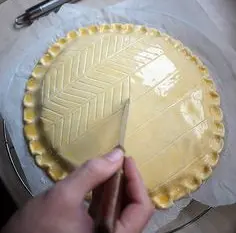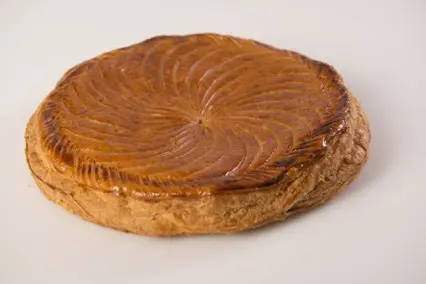This site uses only a few technical cookies necessary for its operation. By continuing to browse, you accept their use.
To find out more...
To find out more...
Drawing a pattern in pastry

Often in the kitchen, in pastry-making, or in baking, we need to trace a pattern on a pastry.
It's just a question of aesthetics but it has its effect after baking on a galette, pithiviers, pâté en croute (terrine in a pie crust), etc.
It's just a question of aesthetics but it has its effect after baking on a galette, pithiviers, pâté en croute (terrine in a pie crust), etc.
35 K 4.1/5 (26 reviews)
Keywords for this post:PastryPatternsDrawingAestheticTracingGildingKnifeLast modified on: May 23th 2019
Drawing a pattern in pastry
It is not very complicated in principle, in general the dough is gilded with a brush and dorure, and then with the tip of a knife you trace the chosen pattern, before either putting it in the oven directly (puff pastry, shortcrust pastry or sweetcrust pastry (pâte sablée)), or putting it in a warm place (milk rolls or croissants, ...).
It's simple in principle, but it deserves some precisions and 1 or 2 tricks, because it's easy to get it wrong.
How to do it?
First of all, we agree, you have to "gild", that is to say to pass some gilding with a brush in a fine and regular layer on the top of the dough. This is important for the colouring when baking of course, but also because by doing this you will create a colour contrast between the dough, golden, and the incisions you will make afterwards, which will show the light, non golden dough. It is this contrast that will give a beautiful pattern when baking.
Then you have to draw the pattern, usually you use a small sharp knife, and that's the trick: you mustn't use the blade of the knife normally (as if you were cutting something), but upside down, that is to say you must use the back of the blade, the one that is thicker and does not cut. And that's because you don't want to split the dough, and in the process risk going through it, but just groove it with the thick side of the knife blade.
And if possible, don't hold the knife by the handle (as on this picture), because you have too much strength and you risk to crush the dough when you should be "airy", but rather hold it by the blade, between thumb and forefinger, handle up, almost like a pen.
Once you have learned this gesture, give free rein to your creativity in terms of decoration and draw the pattern of your choice: grid, spiral, flowers, grid,...
To sum up: To trace a pattern on a pastry before baking, the best way is to use the thick side of the blade of a small knife, holding it upside down, by the blade, pinched between the thumb and the index finger.

It's simple in principle, but it deserves some precisions and 1 or 2 tricks, because it's easy to get it wrong.
How to do it?

First of all, we agree, you have to "gild", that is to say to pass some gilding with a brush in a fine and regular layer on the top of the dough. This is important for the colouring when baking of course, but also because by doing this you will create a colour contrast between the dough, golden, and the incisions you will make afterwards, which will show the light, non golden dough. It is this contrast that will give a beautiful pattern when baking.
Then you have to draw the pattern, usually you use a small sharp knife, and that's the trick: you mustn't use the blade of the knife normally (as if you were cutting something), but upside down, that is to say you must use the back of the blade, the one that is thicker and does not cut. And that's because you don't want to split the dough, and in the process risk going through it, but just groove it with the thick side of the knife blade.

And if possible, don't hold the knife by the handle (as on this picture), because you have too much strength and you risk to crush the dough when you should be "airy", but rather hold it by the blade, between thumb and forefinger, handle up, almost like a pen.
Once you have learned this gesture, give free rein to your creativity in terms of decoration and draw the pattern of your choice: grid, spiral, flowers, grid,...
To sum up: To trace a pattern on a pastry before baking, the best way is to use the thick side of the blade of a small knife, holding it upside down, by the blade, pinched between the thumb and the index finger.
Lasts posts
Butter vs. grease
We often read in a recipe where a pastry is put into a mould that, just before pouring, the mould should be buttered or greased. But what's the difference between these 2 terms?December 1st 20251,4065
Getting out of the fridge early
Very often when you're cooking, you need to take food or preparations out of the fridge, to use them in the recipe in progress. There's nothing tricky about this: you just take them out of the fridge and use them, usually immediately, in the recipe. But is this really a good method?November 24th 20251,2715
Who's making the croissants?
When you look at a bakery from the outside, you naturally think that in the bakery, the bakers make the bread, and in the laboratory, the pastry chefs make the cakes. It's very often like that, with each of these professions having quite different ways of working, but sometimes there's also one...November 23th 20251,161
Oven height
When we put a dish or cake in the oven, we naturally tend to put it on the middle shelf, and that's what we usually do. But in some cases, this position and height can be a little tricky, so let's find out why.October 8th 20253,2435
The importance of sieving
In recipes that use a fine powder (flour, powdered sugar, etc.), you'll often see the advice to sift before using it. To sift is to pass the powder in question through a sieve (a very fine strainer) before incorporating it into your recipe. It's often advice, but is it really useful?September 3rd 20257,8783
Other pages you may also like
The golden-brown finish on puff pastry
Let's take a look at the tricky matter of producing puff pastry with an attractive, golden-brown finish. French pastry chefs call this "dorure" (literally, "gilding"). Behind this quirky term there lurks a real problem (and the solution): when using puff pastry (pâte feuilletée) for a pie, or...February 8th 201848 K 24.6
Egg yolks and caster sugar
We often come across recipes where we need to mix egg yolks with caster sugar. This would appear to be a very ordinary and simple thing to do but, be warned, these two ingredients can behave oddly together.February 15th 201883 K 24.3
Candied fruits: don't get ripped off
Do you like candied fruit? You might like to nibble a handful or add it to a recipe, like a classic fruit cake or delicious Italian specialities like panettone or sicilian epiphany pie.June 21th 201768 K 24.2
The so-called "nervous" meats
You've probably heard this before, we're talking about "nervous" meat, or meat with nerves, to describe what is indicated by the blue arrow on the left. This is a piece of beef, and what we call a nerve is not a nerve, it is in fact collagen (chemists sometimes call it a "collagen sink"), a...April 16th 202137 K4.5
85 grams of eggs?
Some time ago, I already spoke to you about the difference between baking and pastry-making, I emphasized, among other things, the precision of pastry-making which requires grams, cm, degrees and minutes. That's why, on the one hand, you have baking and cooking, where a certain tolerance is...November 26th 201857 K4.6
Post a comment or question
Follow this page
If you are interested in this page, you can "follow" it, by entering your email address here. You will then receive a notification immediately each time the page is modified or a new comment is added. Please note that you will need to confirm this following.
Note: We'll never share your e-mail address with anyone else.
Alternatively: you can subscribe to the mailing list of cooling-ez.com , you will receive a e-mail for each new recipe published on the site.









